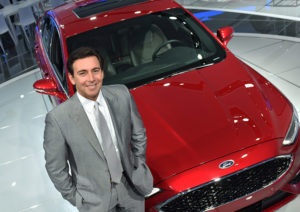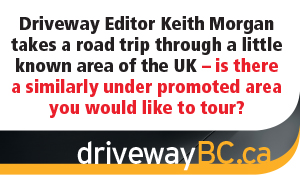Mark Fields, Ford Motor Company president and chief executive officer, believes we’re on the cusp of a mobility revolution.
The visionary leader painted a bright picture of our transportation future in his opening address to the 2016 AutoMobility LA conference, staged with the LA International Auto Show.
“We at Ford are excited about that because we’ve literally spent more than 100 years getting ready for this moment. We’ve always used world fairs as an opportunity to talk about how we envision the future.
“At the 1939 world’s fair, we had an exhibit there we called the “Road of Tomorrow,” he said. “It featured a service station and presented the idea that infrastructure upgrades would soon allow drivers to travel the entire country with ease. At the 1964 world’s fair, Ford created a seven-acre journey ‘into the fabulous future.'”

Detroit, January 12, 2016 — Mark Fields, President, Chief Executive Officer, Ford Motor Company, with the 2017 Ford Fusion at the North American International Auto Show.
Fields drew few laughs when he pointed out that 120 years ago, horses were the cutting edge of personal mobility.
He added: “Before mass production of affordable automobiles, most people never ventured more than10 miles (16 kms) from home. What’s interesting is that the time people spend moving from point A to point B has remained remarkably constant.
“People all over the world are moving, on average, an hour to an hour and a half every day, and that’s been true for several hundred years. What’s changed is the distances people are travelling.”
Today, Ford is not only dreaming about the Road of Tomorrow, but also focused on creating the City of Tomorrow. There are serious challenges, he warned and offered a different view of the congestion problem.
“Imagine if we focused on optimizing roads for the total number of people on them instead of the total number of vehicles. What if we could transform a commute from something painful into an opportunity to take a class, watch a movie or play a game? Or think about this: What would a city look like if more people were using shared services versus personally-owned vehicles?”
“At Ford, we’ve seen how exciting and liberating it is to imagine the future of mobility in this way.”
He explained that Ford responded by creating a City Solutions team to work with cities around the world to help map the future, starting with San Francisco and growing from there.
“We know every city is unique, with different needs and unique transportation challenges. Instead of offering a single set of solutions to all cities, we’re working with each city directly to identify the needs of its citizens and tailor transportation solutions for them.”
He cited the example of an app-based, crowd-sourced shuttle service called Chariot, which offers commuters a way to get to and from public transport locations. It’s operating in San Francisco, Austin and there are plans to roll it out in four more cities soon.
The company is also partnering with Motivate and Bay Area bike share to launch Ford GoBikes, providing yet another way for people to move easily around the city.
“Importantly, leading in these mobility solutions and working together with cities is good for our business. Ford has been a longtime partner to cities as a leading provider of vehicles for police, rescue and taxis in cities around the world. That will continue and even grow as we become closer to key cities, which will improve our core business of building great vehicles.”
Recent Comments
- { Enjoyed your Forest of Bowland in the BMW X5M, particularly the photo of the BMW in front of the main part of Stonyhurst College where... }
- { Bantam designed the Jeep, not Willy's or Ford. The American military gave the original Bantam prototype to Willys and Ford to copy. There is plenty... }
- { All Escalades come with a 6.2-lilter V8 engine that produces 420 horsepower. A six-speed automatic is the only transmission offered and drives the rear wheels.... }
- { Alexandra is an excellent journalist. }
Popular Posts
- Journey to a ‘Sparkling’ Luxury Okanagan Resort “Four lucky readers will put a Dodge Journey’s weekend-...
- The Need For Speed: Hike Those Highway Limits More than half of those polled believe the province sho...
- Drives-U-Crazy… Erratic drivers. An early morning drive from Kelowna to Vancouver is nor...
- Readers Respond: The Pros and Cons of Increasing B.C. Speed Limits Increasing the speed limits will only increase risk to...
- Honda CR-V Review: The Compact Crossover To Get Things Done The CRV is a very stylish and aerodynamic crossover veh...






